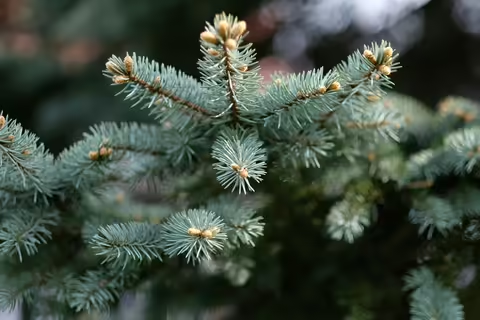URBANA, Ill. – If you have ever purchased or harvested a living or cut Christmas tree, you may have inadvertently brought in some overwintering pests.
Luckily, any concerns about these pests are unwarranted. “Yes, it is true that Christmas trees can harbor dormant pests that become active after being exposed to the warm indoor temperatures, but most of these pests will remain on the tree, while only a few might find their way to your windowsills,” says University of Illinois Extension educator Chris Enroth.
If this has been a problem before or if the very idea of bugs on your tree has stirred up your entomophobia (the fear of insects), Enroth says the best means of control is inspecting the tree before bringing it into the house. While the tree is lying on its side, look up into the tree's interior from the cut end. Examine and remove egg masses, including those of praying mantis, gypsy moth, and bagworms. Remove bird nests, which can harbor parasites, mites, and lice. Make sure to utilize the mechanical tree shaker, available at most tree lots/farms.
Enroth adds, “Chemical sprays should be avoided. Aerosol insect sprays are flammable and should NEVER be used on a Christmas tree.”
Pests that are common in Christmas trees include:
- Adelgids – Commonly found on white pine, adelgids are sedentary and will remain on the tree. They are tiny, aphid-like, sucking insects that secrete a cottony wax filament over their bodies.
- Aphids – All aphids that hatch on Christmas trees target specific species and will not harm your houseplants. Aphids can be confused for spiders or ticks, but these little guys (one-eighth-inch or smaller) have only six legs, as opposed to the arachnids’ eight.
- Predatory mites – These relatives of spiders and chiggers typically overwinter as adults in trees and become active once you bring the tree indoors. Predatory mites are tiny and will likely remain on the tree, feeding on insect or mite eggs, going unnoticed for the entire holiday season.
- Praying mantids – A Female praying mantis commonly prefers Fraser fir Christmas trees for egg-laying. Females will lay 200 to 400 eggs in the fall. She will secrete a frothy liquid that hardens around the egg to protect it from the harsh winter. Once in your warm house, the baby praying mantis can hatch from its egg and will likely then starve. Scout for mantis eggs before bringing the tree indoors. If you find one, cut off the branch it is attached to and place it in an evergreen outside.
These Christmas tree post-harvest pests are rare, occurring in 1 out of 100,000 cut trees. You may never experience any problems with Christmas tree pests, or if you have, you may never encounter them again. Remember, if you do have serious insect pest problems on your Christmas tree, you can always take it back to the supplier and ask for a refund or exchange.
News source/writer: Chris Enroth, 309-837-3939, cenroth@illinois.edu
